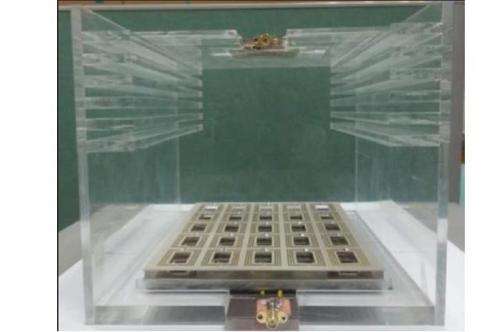Researchers develop new wireless power transfer technique

A wireless power transfer technique that uses miniaturised receivers suitable for real-world use has been demonstrated by researchers in Korea. Hyoungjun Kim and Chulhun Seo from Soongsil University used a metamaterial slab in a resonant coupling method to significantly improve the efficiency of the power transfer, and retain this efficiency over greater distances than previously possible.
Wire free
Wireless power transfer (WPT), in which electric power is transmitted through the overlapping magnetic fields of a transmitter and a receiver without the need for interconnecting wires, has been widely researched in recent years. Ranging from the wireless charging of portable consumer devices, to medical implants and electric vehicles, WPT holds great promise in making a broad range of everyday applications safer and more convenient.
The main WPT method that has been developed uses inductive coupling. This still has a lot of shortcomings that have prevented its uptake in everyday applications, such as a low power transfer efficiency, a short range of only a few centimetres over which the power is transferred, and the need for different and bulky transmitters and receivers. Another WPT method using microwaves has also been studied, but this has issues that need to be resolved, including the effects of the microwaves on the human body.
Resonant coupling
In 2007, a different WPT technique using resonant coupling was introduced by Marin Soljacic and colleagues from MIT. In this technique, the transmitting and receiving coils operate at their resonant frequencies to boost the transfer efficiency. This allows the transmission of the highest power over the longest distances so far.
Although the resonant coupling technique is looking to be the most promising solution, studies into its further development have been quite limited. There are still limitations to the technique that need to be resolved: the size of the transmitter-receiver is determined by the resonant frequency, preventing it from being miniaturised for real-world applications; and, although the technique can transfer power over longer distances, it has a low efficiency and the power transferred decreases with distance.
An efficient approach
Kim and Seo have been studying ways to miniaturise the transmitter and receiver, particularly the miniaturisation of the receiver, as this would allow the wireless recharging of portable devices. They have also been investigating ways to increase the power transfer efficiency. To solve both issues, they designed and used a metamaterial slab that uses the zero refractive index (ZRI) property to focus the energy that leaks from the transmitter back to the receiver.
They achieved the ZRI property by controlling the effective permeability to be close to zero using a spiral structure and a capacitor. The WPT system consisted of the transmitting coil, the receiving coil and the metamaterial slab in between them, with the receiving coil being about the size of a mobile phone battery. The distances between the two coils was varied between 100 and 150 mm, and Kim and Seo found that, not only was the power transfer efficiency doubled at 100mm, but that it was maintained over longer distances, whereas it would drop off in previously reported systems.
Future directions
Kim and Seo believe that the ZRI property technology that they have developed can be used, not only in resonance coupling WPT, but also in other applications such as high gain antennas and magnetic resonance imaging (MRI) systems. A big challenge to get this system into real-world use, however, is the development of a metamaterial that uses a cheap, commercially-available board as opposed to the more expensive, low-loss board used in this work.
Kim and Seo's research group are studying not only ZRI, but also negative refractive index (NRI) as a possible solution. They are also working on developing WPT technology and transmitters with 3D structures instead of the existing 2D structure, which would enable wireless power transfer, regardless of the locations of the receivers.
More information: "Highly efficient wireless power transfer using metamaterial slab with zero refractive property." Hyoungjun Kim and Chulhun Seo. Electronics Letters, Volume 50, Issue 16, 31 July 2014, p. 1158 – 1160. DOI: 10.1049/el.2014.1596 , Print ISSN 0013-5194, Online ISSN 1350-911X
Journal information: Electronics Letters
Provided by Institution of Engineering and Technology
This story is published courtesy of Electronics Letters. For additional Electronics Letters news and features visit theiet.org/eletters.




















